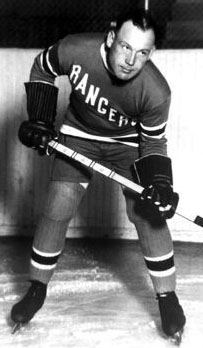Will Return

In 1971, Paul Revere and the Raiders released “Indian Reservation: The Lament of the Cherokee Reservation” that described the marginalization of Native Americans in the land they once called their own. A lyric stated, “They took the whole Indian nation/And locked us on this reservation/Though I wear a shirt and tie/I’m still a red man deep inside.” The words are ones which hockey great John Clarence “Taffy” Abel could well have related.
Foster Hewitt, the Canadian sport broadcaster known for his catchphrase, “He shoots, he scores!” was a phrase that did not apply to indigenous athletes-including a man who devoted his life to the sport. As much as The Lion, the Witch, and the Wardrobe’s Edmund Pevensie loved Turkish Delight was as much as John loved taffy that led to his nickname. Taffy was born on May 28, 1900, in the northern Michigan town of Sault Ste. Marie, near his tribe’s reservation. His Caucasian father, John, was a travelling salesman; his mother, Charlotte, stayed at home to raise Taffy and his younger sister, Gertrude. Charlotte was a member of the Chippewa Sault (pronounced Soo) First Indian Nation, currently called the Ojibwe. She conversed with her two children in her native language but cautioned them not to speak it at school.
From an early age, as he had light skin, Taffy was able to camouflage his heritage that saved his forcible removal from his family. The government sent Native American children to boarding schools to assimilate them into white culture. Philip Deloria, a Harvard professor, stated, “In the context of assimilation -- in which Native people were literally educated to be ashamed of their Native identities -- mixed race children who looked 'white' may have found it easier to let themselves be identified as 'white,' 'assimilated,' 'civilized' than to assert a Native identity." The song captured the practice, “Took away our native tongue/And taught their English to our young…”
In addition to his love of the candy, Taffy loved hockey which he practiced in a makeshift rink in his backyard. Upon his father’s 1920 death, Taffy became the breadwinner for his mother and sister. He made money shoveling the snow off local ice rinks, a job that allowed him to skate on his off hours. Along with his best friend, Sam Kokko, they organized the Sweepers that went on to compete regionally and earned an amateur championship. Due to his six-foot-one height, and 225-pound weight, Taffy earned his secondary nickname of Michigan Mountain. His overly aggressive on ice tactics often resulted in spending time in the penalty box. At age nineteen, Taffy played for the Sault Wildcats, a position he held for the next three years. A 1922 match between the Wildcats and the Canadian Soo drew 20,000 fans. Although his team lost, the Sault newspaper described their standout hometown player, “Taffy jarred the carcasses of the Canadians.”
In 1924, the Olympic Committee was putting together the first-ever winter hockey game, and they recruited the player known as the best on the ice. The committee sent Taffy a telegram asking him to make his way to Boston where the fledging team would board a ship for Europe. Although the offer surpassed his wildest dreams, Taffy declined as he did not have the funds for a train ticket. Taffy’s friends came up with the money. What they could not come up with was a passport, or his birth certificate. However, the ship personnel said Taffy would be able to board without official documents if someone signed an affidavit attesting to his identity. Teammate Herb Drury signed the document, testifying he had known Taffy since childhood. The affidavit passed muster although Herb was from Midland, Ontario, hundreds of miles, and across the border, from Sault. After several days in Boston, the Olympians departed for New York City where they boarded the luxury liner the SS President Garfield that would ferry them across the Atlantic.
The historic 1924 Chamonix Olympic game inspired the 1981 nonfiction film Chariots of Fire that depicted two British athletes who participated in the Paris Games. The first Native American to participate in the Winter Olympics is also worthy of a screenplay. As engaging off the ice as he was on, teammates elected Taffy captain. Forty-eight stars and thirteen stripes waved as Taffy walked the streets of Chamonix, France, where he held the American flag aloft during a pre-game procession. The American men’s hockey team won a silver medal; they failed to take home the gold after losing 6-1 to Canada in the final game. In a 1964 robbery, the thief made off with the then deceased Taffy’s silver medal, scrapbooks, and photographs that police never recovered. Newspaper accounts of the game described “stains that turned the ice crimson from bloody noses.” A secondary report recounted a collision between Taffy and another player that “echoed to the top of Mont Blanc.” European fans were aghast at the violence of the North American victors.
A hero’s welcome awaited the small-town boy who had garnered a silver Olympic medal. Hundreds greeted him at the train station and his fans hosted a banquet where they presented him with a gold watch. In his speech, Taffy said, “This city can count on me ... to help put the old town on the map." In 1926, Taffy wed Irene Anderson; after their divorce, in 1929, he wed Tracy Adeline Rickena, a union that lasted until his passing. He never had children.
Post Olympics, Taffy played for eight years in the National Hockey League. Although denying his roots contributed to his drinking, such were the times that he had to continue to keep his secret under wraps. In that era, there was no athlete’s union, and if the manager did not like a player, he could send him back to the minor league. At this juncture, Conn Smythe-the future founder and owner of the Toronto Maple Leafs- was scouting for a player for the New York Rangers’ inaugural season. Smythe travelled to Minnesota to check out potential players and decided John Clarence Abel was the best bet. However, Taffy did not accept the offer. Unwilling to take no for an answer, Smythe tracked him down at the train station where Taffy had already boarded. Negotiating from the open window, Taffy acquiesced. While some people like to make dramatic entrances, Taffy made a dramatic exit: he jumped from the moving train and signed the proffered contract.
Smythe’s premonition proved prescient: In the inaugural game at Madison Square Gardens Taffy helped the New York Rangers win the Stanley Cup-so named after the British Lord Stanley- in the match against the Montreal Maroons. Whenever a stranger asked Michigan Mountain what he did for a living, his stock response-he “was in the business of winning.” In 1929, the Chicago Blackhawks purchased Abel's contract for a reported $15,000. The Blackhawks and Taffy fell out over a contract dispute. An embittered Taffy left his number two sweater behind and departed to Sault where he took a temporary job at a brewery. When the Chicago team fell behind in a 5-0 game, disgruntled fans chanted, “We want Taffy!”
In 1934, after 333 games in the National Hockey League, Taffy, substantially heavier, retired. In Sault, Taffy and Tracy operated the Log Cabin Café that a reporter for the Chicago Daily Tribune wrote was, “the gayest spot on Michigan north of Detroit…bringing in all the name bands on tour.” The next business venture was the Log Cabin Lodge whose windows offered a vista of St. Marys River.
However, Taffy never abandoned his love for his sport and in 1938 Taffy became the coach of the newly formed Sault Americans. The owners claimed they fired him because of missed practices. Sam Koko later admitted the reason for the dismissal was Taffy had punched manager A. J. Sorenson.
Five years later, upon his mother’s death, Taffy founded his own team: the Sault Indians, the first public acknowledgement of his heritage. He coached the Sault to three consecutive championships. Taffy passed away from a heart attack at age sixty-four; his obituary did not mention his heritage. Indeed, those outside his hometown did not discover his roots until the American Indian Athletic Halll of Fame inducted him in 1990, an act spearheaded by the Sault tribe of Chippewa Indians. Other posthumous tributes: the United States Hockey Hall of Fame made him a member, Lake Superior State University called its 4,000-seat arena bears the name Clarence John “Taffy” Abel, and the Sault’s Pullar Stadium installed his larger-than life photo by its entrance. A recent tribute took place in 2012 when the Smithsonian National Museum of the American Indian featured him in an exhibition.
History remembers Taffy as the first Native American to participate in the Winter Olympics and the first Native American to play in the National Hockey League. Although racism still rears its head the closing chorus of Paul Rever and the Raider’s song echoes hope, “But maybe someday when they’ve learned/Cherokee Nation will return…”


